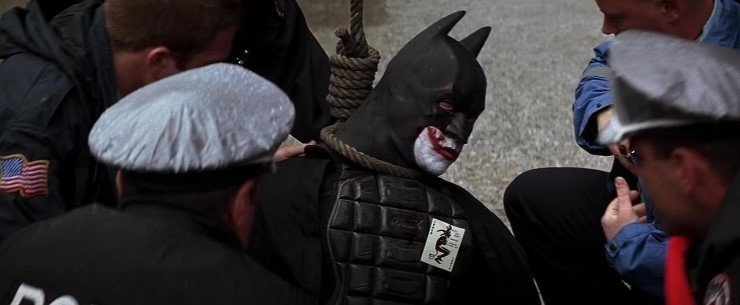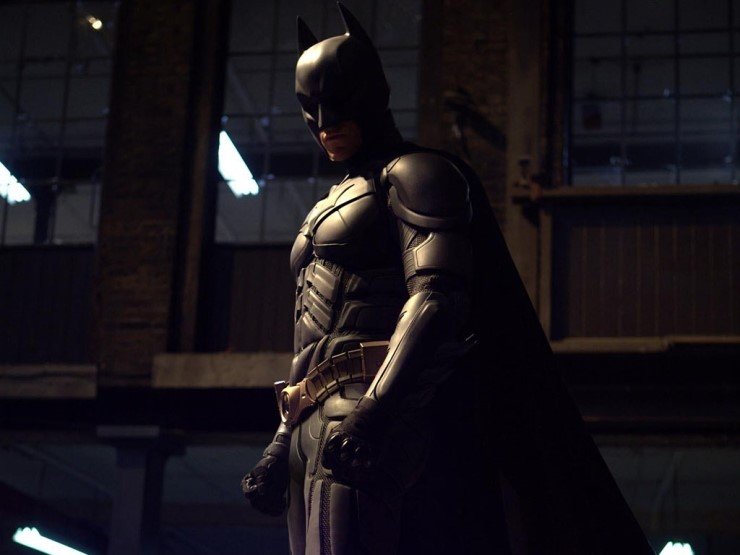Dark Knight - A Masked Agamben
The finest in Nolan's trilogy, Dark Knight is not only the best Batman movie ever made but also the greatest work of art in the director's filmography. The elaborate narrative doesn't allow a single plot hole to destroy its coherency. In an intensive Michael Mann-Esque film noir adaptation, the narrative of the dilemmatic hero engulfs Gotham and its citizens.
The bat signal in the night sky has criminals cowering in fear. Harvey Dent, Gotham's handsome young District Attorney, successfully puts half the mob in jail. It seems the city of crime has finally found peace.
However, the horrifying appearance of the Joker, followed by a scene where our vigilante beats up the criminals, foreshadows discord hidden beneath the momentary peace. Batman’s fanboy and the Joker’s squad wear masks and make-up, talking about their disguises, yet Batman himself can’t tell the difference between them. The hypocrisy of Batman is made apparent in this ironic contradiction. The rich vigilante who stands outside the system is a mirror image of the cheap hockey-masked outlaws.
‘One of the reasons that Christopher Nolan cast Aaron Eckhart as Harvey Dent was that he has a typical American face.’
Bruce Wayne is also aware of this dilemma. One who wields arbitrary power can create a temporary solution but cannot be a perpetual dispenser of justice. This masked vigilante, a superhero, cannot answer the unspoken question of what grounds he has for the authority and power he holds in the night city. (Benjamin. W) On the other hand, Harvey Dent mirrors what Bruce Wayne wants to be: The ideal civic spirit of America. He doesn’t need to wear a mask or jump from rooftop to rooftop. Remember that Gordon calls him the white knight of Gotham. He puts half of the mob behind bars legitimately. He even tells the mob boss in court, “If you want to kill an American prosecutor, use an American gun.” Consequently, this ideal white knight of the republic has been selected by Batman to protect Gotham after he disappears.
However, one can clearly sense the turbulence that threatens this ideal plan creeping out from every shadow on the screen. The trilogy reflects current events in the real world. The sovereign of Gotham has become more drastic, just as the U.S. did throughout the war on terror and Iraq. The judicial system, intended to protect society, has come instead to depend on the masked sovereign. Perhaps that’s why Wayne mansion never appears in the movie despite Bruce saying that he will rebuild this idyllic place in the previous film.
In the shadows, Batman stares at the prosecutor and the chief of the police arguing on the rooftop of the police building. When judicial power isn’t properly functioning, Batman attacks the enemies Gotham's authorities cannot deal with, like a deus ex machina cutting through the tangled lines of a narrative. Going further than destroying police cars in the prequel, the masked vigilante flies to China, which has no extradition treaty with America and brings Liu to Gotham. Neither borders nor international laws can stop this outrageous one-man police.
Mask and Make up
The repercussions of this power put the city in great danger as the Joker's plan is set in motion. The civil vigilante who appeared at the movie's beginning is hanged with a mask and makeup on his face. This represents the fact that Batman's mask and the Joker's makeup are the same signifiers of extrajudicial actions: The power of the sovereign. Bruce tracks down the Joker, but cannot find any clues. The narrative deliberately redacts the background of the Joker, including his fingerprints and a trademark of his clothes. The Joker's identity is hidden from Bruce Wayne and the audience in the same way that Batman's identity is hidden from the people of Gotham. Neither the mysterious hero nor the villain can be identified, even the chief of the police force, the head prosecutor, and the mayor of Gotham. Both leave the question of the source of their authority and power unanswered. On top of this, both Batman and Joker try to impart their messages to the city using their symbols. The mechanism of a terror attack is not intended to win a battle but to construct a semiology of fear.
The commonality between the methodology of the masked hero and that of the Joker is that they are both building a relationship between a symbol and a studied phobic reaction in people's minds. This daring arrangement of the characters' natures creates significant political implications (Benjamin. W), revealing the shared characteristics of Batman and the Joker more than any other Batman content has before.
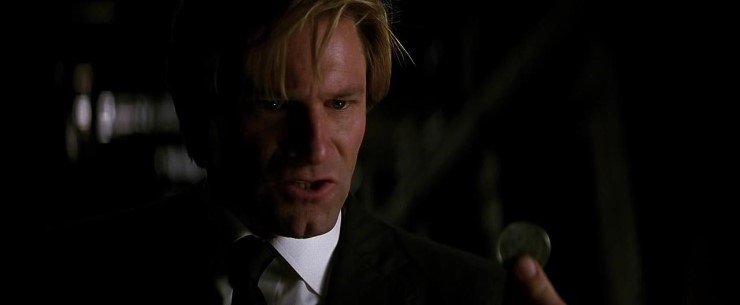
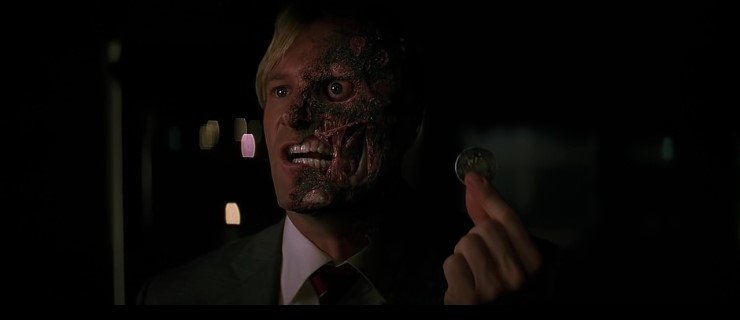
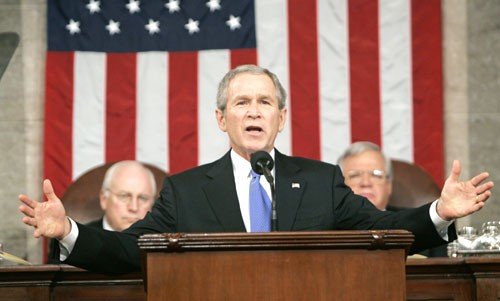
The vigilante hero's innate irony and limitations have risen from the city's gutter and slowly engulfed the city that was dependent on it for peace. Harvey Dent, the ideal of American justice, begins to reveal what he has been incubating as the chaos sweeps the city. While threatening the prisoner, Harvey's coin always lands heads-up. As in No Country for Old Men, and as Harvey himself says, the one who makes the decision is the one who flips the coin. The prisoner is only given a dead end disguised as freedom of choice. The consistent low angle of the camera on Harvy's close-ups creates a composition similar to that of the scene where Batman peers down at Gotham from the rooftop. All of this hints that the white knight has been implanted with the seed of corruption. When the masked vigilante flew across the borders with a dual kevlar suit, after justice decided to compromise with the sovereign, as the Joker says: "All it takes is a little push." Consequently, Michael Caine's statement, "While Superman is how America views itself, Batman is how the rest of the world views America," is achingly accurate.
Needless to say, what made Ayatollah Khomeini was America itself. With its superior traditional military power and the legacy of Kissinger, America supplied the Pahlavi Dynasty, Pinochet, and other dictators, instigated atrocities in Cambodia and Argentina, and waged wars across the globe. The Bush administration was, in fact, an extended chapter of Kissinger's and Carter’s policies. The monster that America created, which neither APTs nor Tomahawks can kill, has returned to its spawning pool: Gotham. As Tim Burton showed in his Batman movies that the Joker and Batman created each other, Nolan's The Dark Knight also confirms that the Joker and Batman give rise to each other.
The film takes the discourse even further than this. While Batman Begins showed how America crowned the sovereign, The Dark Knight outlines how America imploded due to the repercussions of its outrageous sovereignty. The Joker’s blackmail with the brutal image of himself and his hostages is reminiscent of terrorists imparting fear. The city sinks into the depths of despair, and the citizens become terrified. Passing through the allegorical scenes where the frightened citizens comply with the Joker’s demand and Bruce Wayne is attacked by the Gotham police, the audience arrives at the Joker’s social experiment.
In most modern democratic systems, the usurpation of democratic power is almost impossible because the concept of democracy is so firm and stable. However, as Agamben pointed out, the sovereign dictatorship has been invited as a new normal, a political measure taken by the citizen. When the volatile multitude compromises with given options and takes producing homo sacers for granted as a measure against the state of exception, the system helplessly collapses, allowing madness to tear the republic apart from the inside. History witnessed such democratic tragedy in Weimarer Republik, the Kingdom of Italy, and the US. The obvious metaphor for mobocracy in the wake of the terrorist attack plays out in two ferries, named Spirit and Liberty. In the twisted Prisoner's Dilemma, these two virtues, unable to communicate, end up deciding to vote to destroy each other. We should remember that all the bloodbaths that the George Bush administration brought about were engineered by authorities wielding power granted to them by U.S. citizens. Like the passengers in the ferries voted for killing, a bloodbath that seems lawful and logical was executed "fairly" and "systematically."
In this scene, for the first time, Lucious Fox meets Batman, not Bruce Wayne.
The madness that lurks in the civilized system devours everyone. Harvey Dent, who was once the White Knight of Gotham, becomes Two-Face. His almighty coin becomes a weapon. Heads or tails—it doesn't matter. Those whom Two-Face wants to die will die. Even Batman crosses the line to get to the Joker. His plan—turning all the cell phones in Gotham into sonar radar—is an aesthetic metaphor for the Patriot Act in the US. Adapting the concept of bio-power of Foucault, Agamben made it clear that the sovereign power doesn't get rid of homo scars but ceaselessly adjusts the border of 'who is homo scars' according to its favor. In other words, there is no escape in this giant panopticon. Enthroned sovereign take everyone in the society prisoner. Not to be homo scars, one must surrender to the power and become possible homo scars.
This endless cycle of tragedy is justified in the name of safety. Pointing out this cycle as he hangs upside down, the Joker tells Batman, "We are destined to fight like this forever."' Slowly, the screen turns around and reveals that the Joker has won. Bruce Wayne's plan to enthrone real justice in Gotham and destroy Batman completely fails. As with Gordon's line in Batman Begins, the Joker's line signifies that there is no winner in this recurring cycle of tragedy.
Terrorism achieved its purpose the moment America retaliated against it with terror as its weapon. Nietzsche’s saying, which the Joker twists into "What does not kill you simply makes you stranger," envelopes America. The city is overwhelmed by fear. Bruce’s plan failed, and the white knight killed police and took civilians, hostage. The democratic system has shown how disgusting it can be. As Gordon says, the Joker has won. The madness of the US, which mobilized the methodology of terrorists to fight the terrorists, is made apparent in the Joker's line,' I took Gotham's white knight, and I brought him down to our level.'
However, there is still a spark of hope. The Joker’s plan to blow up the ferries was defeated by a prisoner who refused the Prisoner’s dilemma. The way out of a dilemma that presents a delusion of choice between pre-given selections is to repudiate the dilemma itself. Although the fight against terrorism seems to have only violent options, the ironic civic spirit proves that there is another way; an exit.
Moreover, the one who embodies Nietzsche's original saying, 'What doesn't kill you makes you stronger,' is still alive: Batman, whom Christopher Nolan has modeled after Hercules. If he reveals the truth about Harvey, Gotham will fall, and as Gordon says, this tragedy is way too big to hide. As the prisoner did, Batman refuses the options that seem to be a dead end. Gordon gets the head of the coin only because Batman refused to play Harvey's game. As Hercules fulfilled his heroic destiny despite all the false charges made upon him, Batman puts himself into the dilemma of the Joker, being accused of false charges to save Gotham. At the end of the movie, giving up his sovereign power, sacrificing himself to break the Joker's puzzle, the Dark Knight ascends from underground into the light.
The reason the film leaves a bittersweet taste after the screen turns black is because of its brave representation of the aspects of the world we live in. Without compromising with the obsession with making a commercially successful hero, Nolan boldly shapes this hero with the anxiety of the current world. The bare face of Gotham is not only a reflection of America but also of the reality of politics today. As Agamben pointed out, the state of exception has been welcomed as a governing paradigm in our political construct. The Dark Knight runs here and there, striving to save his city, but before the internal madness and failure of the democratic system, he can’t help accepting the fact that he fed the abyss of the city.
The hero relying on the panopticon, can’t dispense justice but must make his lonely exit. When violence is crowned and haunts our time, and justice itself is in political asylum, this story of the depressed hero remains a relevant signifier.



